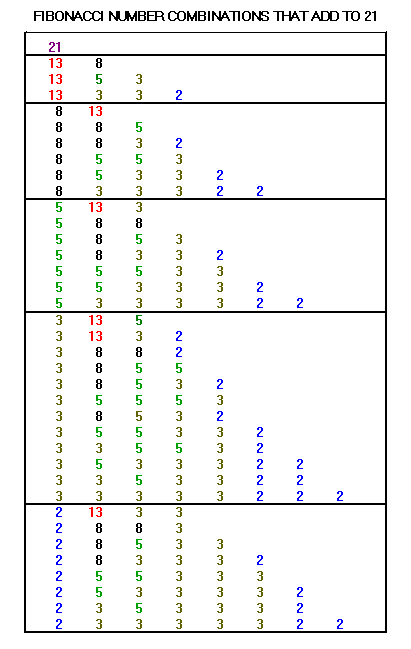|
Strategy and a few more Rules -
Fibonacci 21©
A player’s first goal is to get all of the required base
cards and card 21, on the table. The number 2
bonus card and one or more wild cards can be used in
place of any base card and card 21.
With the base in place, the player can turn over card 21,
closing that one card set, and start adding to the base cards to
make sets. Cards can be moved from one open set to another at
any time. However, cards can only be placed in an open set from
a players hand or returned from an open set to a players hand
during a players turn. Cards in closed sets cannot be moved.
Sets
can only be closed and turned over, during a players turn.
A player can slow down the following player by delaying the
discard of a base card that the next player appears to need.
The number of card combinations that can make a set depends on
the Fibonacci number on the base card. The longest sets can be
created with base cards 2 and 3. These sets consist of eight cards,
three 2’s and five 3’s including the base card. The shortest
set is, of course, card 21. The number of possible combinations
for the base cards 2, 3, 5, 8, 13 and 21 is 8, 12, 7, 6, 3,
and 1 respectively. A table with all the possible combinations
is shown at the bottom of this page.
A set starting with base card 2 must contain at least one card
3 in order to add to 21. With experience a player will start
remembering all the combinations that “work” for each base card.
Players may find it helpful to have a pencil and paper at hand
during the game.
Cards
in a players hand and wild cards or in open sets count against a
player’s score if another player goes out. Players should meld
these cards and close sets if it appears that another player is
about to go out.
High number cards allow sets to be completed faster. For example
card on top of base card 34 immediately creates a set.
Lower numbered cards in a players hand have either to
be melded or discarded before a player can go out.
Replacing a high numbered card in an open set with several lower
numbered cards in a players hand reduces the number of cards in
a player’s hand. This is a good move if the player is planning
to go out or if another player has closed all six sets and is
discarding cards on the way to going out. Remember, a card in
the hand is penalized at twice the rate of a card on the table
in an open set.
The number of cards in a players hand can be reduced by lowering
the designated number of a wild card in an open set, (e.g. from
13 to 5, a reduction of 8) and adding cards (e.g. 3, 3 and 2, an
increase of 8) from the hand to
the set.
The game involves: (i) luck, in being dealt or in drawing useful
cards, and (ii) skill in choosing combinations that build
complete sets from the cards available to the player while
minimizing the number of cards that have to be discarded.


|